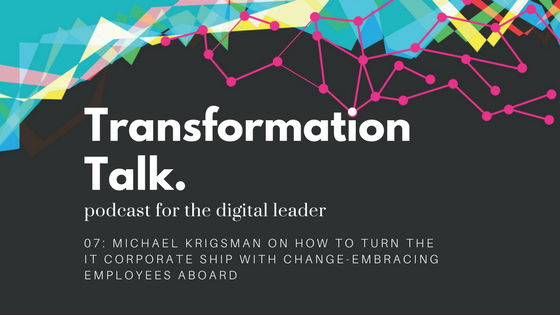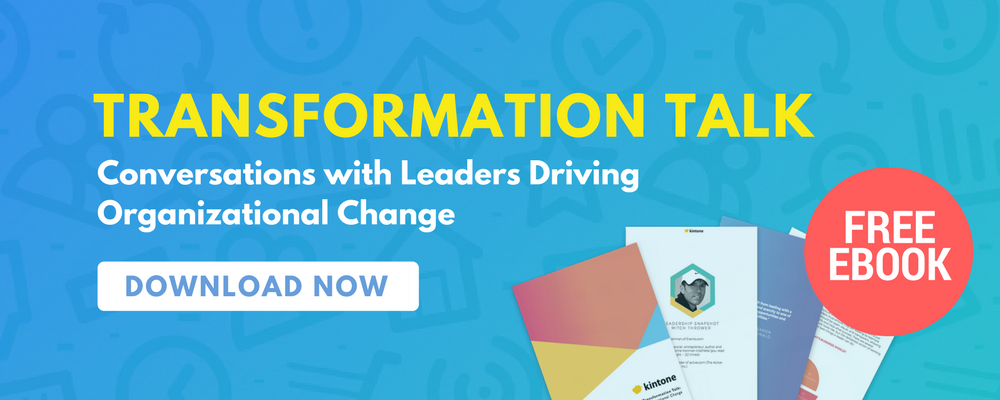This week, we're speaking to Michael Krigsman, internationally-recognized business analyst, keynote speaker and host of CXOTalk.
 For over four years on CXOTalk, Michael has interviewed the world's top business leaders live on video. He's conducted hundreds of interviews on topics ranging from the future of technology to digital transformation and education, to the role of women in tech and much more.
For over four years on CXOTalk, Michael has interviewed the world's top business leaders live on video. He's conducted hundreds of interviews on topics ranging from the future of technology to digital transformation and education, to the role of women in tech and much more.
In addition to CXOTalk, Michael also writes for ZDNet. In his column, “Beyond IT Failures,” he's written over 1,000 articles addressing the management and leadership issues that can lead to failures in IT. Michael also sits as an honorary executive fellow at the Center for Digital Strategies at Dartmouth's Tuck School of Business and speaks at industry conferences and events worldwide.
What are the big themes you discuss on CXOTalk, and how did it start?
CXOTalk is a video interview show, and the key set of themes revolve around how organizations respond to changes in their digital environment. CXOTalk is speaking with innovative leaders, trying to understand what's going on in their industries and their companies, and how are they looking into the future.
I was an industry analyst for many years, and about four and a half years ago, I just had this idea: “Why don't we do a video show speaking with these people?” It began as a labor of love and I just did it. That's how it started.
Do you believe that every company in every industry should be considering the role of technology in their organization?
Today, if you're not thinking about technology and how software can help enable a different relationship with your customers and partners (more efficient, more engaged), then you're at risk of lagging behind. Yes, every industry, every company needs to be thinking about these issues if they're looking forward to being competitive in their future.
In digital transformation, what impacts a business more, the line of business managers, or the C-Suite?
It requires both. Changing a business model should come from the top down. “We have to rejigger our core business and rethink how we’re generating revenue.” That’s a senior management decision.
However, a big part is undertaking the process of transformation, and it involves getting people inside the organization to develop a new mindset. Turning the “corporate ship” requires a C-level agenda, but it equally requires people across the company to get on board with it as they make daily practical business decisions.
In your ZDNet column, “Beyond IT Failures,” you’ve written about leadership issues preventing IT failure. What challenges do you see in IT leadership, especially in large companies?
My original column was called “IT Project Failures” and it focused on large IT meltdowns. Eventually, I flipped it to be “Beyond IT Failures,” because the success of an IT project isn’t dictated by technology. It’s dictated by relationships.
Dysfunctional relationships are when people or teams aren’t communicating. But if you turn that around and have a safe environment where people can communicate and share information, even if it’s not what managers want to hear, then a lot of things change.
The first thing that changes is that instead of saying “It’s us against them,” suddenly you have “Can we work together on this?” Now you have innovation. The mindset morphs from being very negative into a positive, collaborative, innovative style. That’s why I shifted to Beyond IT Failures. Rather than focusing on the dysfunctional elements, I wanted to focus on the stuff that works.
What’s your advice to a company who wants to have a culture of transparency, openness and collaboration, but doesn’t know where to begin?
Look in the mirror and get a clear understanding of what’s going on in your company. Be willing to go through the painful process of hearing what’s wrong. Begin there, and then ask: Where are we going? Are we trying to change our business model? Are we under a competitive threat? Are we driven by a core desire for innovation? Eventually you develop a strategy, hopefully in consultation with others inside the organization. The next step is magnetizing people within the organization and getting them to evolve and adapt themselves.
There will be three groups of people. One group will say “We’ve always done it this way and I’m not changing.” If you want change to happen, you don’t want to talk to those folks. In another group, many people will say “I’m willing to do this, but I’m under pressure in my current job and I need to focus on that.” Then there’s going to be a smaller group who will say “This is great. I want to get involved.” When you find folks like that, influencers within the organization, you can demonstrate quick successes with them and show other people. You’ll know you’ve gotten somewhere when you can go back to the original naysayers and get them on board because you’ve demonstrated that this can really work. And that’s powerful because everyone knows they used to be naysayers. One of the most important dimensions of change management, and digital transformation, is helping encourage a willingness to change mindset that permeates throughout the whole company.
Let’s switch gears and talk about artificial intelligence. What’s the most exciting application of AI that you’re seeing right now?
The challenge of artificial intelligence is seeing through the hype. The other day on my show, I spoke to Scott Brinker, who writes the Chief Martec blog. I asked him this question and he said, “Artificial intelligence is not really a category. It’s an enabler that everyone wants to adopt to make their product better.”
For me, it’s hard to say, but I think we can agree that machine learning and artificial intelligence methods will have an increasingly profound impact on how we think in our work and in our leisure activities.
In your role as an Executive Fellow at Dartmouth’s Tuck School of Business, what do you see as the top skills that students will need in the future of digital business?
The best leaders are ones who are quick to listen and grasp what’s going on. But intelligence by itself is not sufficient to create a well-rounded leader. It requires an emotional intelligence as well, where you are using your intuition and not just the analytical part of your intellect to grasp what other people are saying and what they mean. It’s looking at data, a two-dimensional representation of the world, and being able to say, “The data is telling us this and here’s what it means for human behavior and the behavior of markets. Here’s what it means for what we should be doing going forward.” It’s pretty unique for somebody to have all of this wrapped up in one package, but when you do, they’re pretty extraordinary individuals.
As far as practical skills go, data science is key. In a world where artificial intelligence is ever more present, understanding and being able to work with data is a crucial skill, and the sign of a really good education.
Follow Michael on Twitter @mkrigsman
About the Author
Nicole is Director of Marketing at Kintone, with 10+ years experience in content strategy, campaign management, lead acquisition and building positive work cultures of empowered, purpose-driven team members. She spent seven years as a journalist, previously serving as a CBS San Francisco digital producer, NPR contributor, Patagon Journal deputy editor and reporter for several publications, including the Chicago Tribune. She's passionate about the tech for good space, social entrepreneurship and women leadership. On the weekends, you’ll likely find her putting her Master Gardener skills to use in at community gardens in Oakland.











